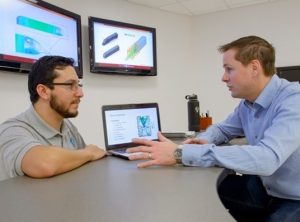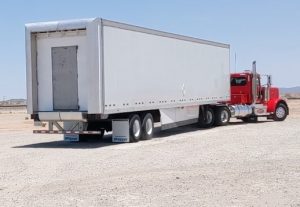
Now envision trailers that incorporate a device that actively shapes the pattern of air flow around the back of the trailer. Using inputs from sensors and direct air injection, the device changes the aerodynamic profile of the vehicle in real-time. This reduces drag and thereby lowers fuel consumption per vehicle mile, shrinking the semi-truck’s carbon footprint.
The device is the creation of Aeromutable’s co-founders Dr. David Manosalvas-Kjono and Dr. Sandra Manosalvas-Kjono, who serve as CEO and COO respectively. They founded Aeromutable while they were doctoral students in engineering at Stanford University. The knowledge that David gleaned in graduate school placed him on the career path of heavy-vehicle aerodynamics, which has included work at companies such as NASA and SpaceX.
“The ability to sense the vehicle’s environment makes our product the first truly dynamic system capable of improving the vehicle performance based on real road conditions,” he said.
David Manosalvas-Kjono is a member of Chain Reaction Innovations (CRI) Cohort 2 at the U.S. Department of Energy’s (DOE) Argonne National Laboratory. CRI is a two-year entrepreneurship program which embeds innovators in the Lab to develop their technologies and grow their early-stage companies. While embedded, he has worked with Dr. Thomas Wallner, Section Manager of the Advanced Mobility and Grid Integration Technology at Argonne.
HOW IT WORKS
Unlike other aerodynamic add-on devices on the market today which are passive, Aeromutable’s active aerodynamic modification system “senses the environment around the vehicle and uses an Artificial Intelligence (AI) powered controller to determine how to change the aerodynamic profile using air injection,” David said. A sheet of air is injected along the edge of the back of the trailer, preventing the formation of unstable vortices that give rise to high-level aerodynamic drag. An important added benefit is that the trailer is more stable and safer to handle, particularly in high cross-wind situations.
Aeromutable’s device “senses the environment around the vehicle and uses an Artificial Intelligence (AI) powered controller to determine how to change the aerodynamic profile using air injection.”–David Manosalvas-Kjono
“This approach unlocks savings that cannot be realized with passive systems and opens the door for other types of optimization objectives such as stability enhancements,” he said. “The dynamic nature of our system is one of the reasons why our performance is so much better than anything currently available.”
Aeromutable’s aerodynamic add-on device “mounts to the back of a semi-trailer and uses air injection to change the aerodynamic profile of the vehicle,” David said.

This device is composed of three separate systems that work together to change the vehicle performance. First, sensors are able to accurately represent the micro-climate surrounding the vehicle. Next the AI powered controller uses this information to determine the best way to change the aerodynamic profile and finally it prescribes the optimum air injection configuration to improve the vehicle’s performance.
MILESTONES
Since joining Cohort 2, Aeromutable has reached several milestones, including participation in the National Science Foundation (NSF) National I-Corps program funded through an NSF Small Business Innovation Research (SBIR) Phase 0 grant, as well as being awarded an NSF SBIR Phase I. In addition, they received 1st place in the 2020 Cleantech Open Regional Pitch Competition, 2nd place in the 2020 Cleantech Open National Pitch Competition, and 2nd place in the VERGE 20 Transportation pitch competition.
IMPACT
Where the work at Stanford focused on simulation, since joining CRI Aeromutable developed multiple prototypes to demonstrate the potential fuel savings in real-world conditions. Its first on-road testing campaign with a full-scale prototype was held during the summer of 2021 and demonstrated an astonishing 29 percent fuel savings while the vehicle traveled at a constant 60mph with minimal stops and no altitude changes. Energy consumed by the device was factored into the calculations.
The overall trip included climbing from sea level to 4000ft twice, multiple changes in vehicle speed–due to highway regulations, multiple stops, and city traffic. This extended 6-hour out-and-back trip along Highway 8 from San Diego, CA to Yuma, AZ, showed an overall fuel savings of 13 percent when altitude and start-stops were factored in. Future enhancements are expected to increase performance to over 16 percent. Next year, the company plans to use its device to carry loads in collaboration with a trucking fleet, with an official pilot anticipated for 2023.

The invention’s ability to reduce drag via aerodynamic modifications lowers fuel consumption, which translates to lower operating costs for trucking fleets, and decreases the carbon footprint of this industry.
“If fully adopted globally by every semi-truck on the road today, our technology has the potential to reduce the production of more than 450 million tons of CO₂ equivalent emissions per year,” David said. “In the US alone it has the potential to decrease the production of 105 million tons of CO2 equivalent each year.”
Furthermore, since this innovation is platform agnostic, as heavy transportation shift towards electric vehicles, the energy savings will continue to be realized and become even greater due to behind-the-scenes technology integration.
David Manosalvas-Kjono is a member of cohort 2, the second class of innovators to participate in the Chain Reaction Innovations program at Argonne National Laboratory.
Chain Reaction Innovations provides innovators with laboratory tools and seed capital as well as the technical, business and manufacturing expertise needed to rapidly mature their early-stage technologies. The goal is to enable them to attract the long-term capital and commercial partners needed to scale and launch into the marketplace.
CRI is part of the Lab-Embedded Entrepreneurship Programs supported by the U.S. Department of Energy’s Office of Energy Efficiency and Renewable Energy (EERE). EERE created the Lab-Embedded Entrepreneurship Programs to provide an institutional home for innovative postdoctoral researchers to build their research into products and train to be entrepreneurs. The two-year program for each innovator is funded by EERE’s Advanced Manufacturing Office (AMO).

